Curriculum Intent for Design Technology
Our D&T curriculum helps to inspire children to exercise their creativity through designing and making structures, mechanisms, textiles and food products.
It challenges children to think outside the box and be innovative in designing and making new products alongside evaluating and improving their work.
Through our teaching of the IPC, our D&T lessons will engage children in active projects that develop creative thinking skills.
At Woodcote Primary School, we are committed to delivering a DT curriculum accessible to all which provides the broadest possible range of opportunities for students. Design and Technology is an inspiring, rigorous and practical subject. Using creativity and imagination, pupils are equipped with the skills to design and make products that solve real and relevant problems, within a variety of contexts.
At Woodcote Primary School, children are taught to select and use appropriate tools safely and effectively to build or put together a product of their creation. In all areas of Design and Technology the children are encouraged to consider the effectiveness of their designs and requirements of the product – promoting self-evaluation and independent drive. Every child will have the opportunity to learn and extend their understanding, experience and application in the use of technology, in as wide a variety of situations as possible.
From EYFS through to the end of KS2, children build and apply their knowledge and skills to research, design, make and evaluate products. The Woodcote Design and Technology curriculum will encompass the National Curriculum requirements to ensure all aspects, knowledge and skills of Design and Technology are being taught across all year groups. Children learn about food technology, textiles, construction and materials throughout their DT journey. Design and Technology offers the opportunity for children to draw on a range of subject knowledge through cross curricular activities and tasks, in all areas including: mathematics, science, engineering, computing and art.
In both KS1 and KS2, the IPC is used in order to inform planning and also ensure correct curriculum coverage from Years 1 to 6. This curriculum is designed to give children a chance to experience different types of D.T. from food to textiles to building and making. By teaching D.T. through IPC, we cover the National Curriculum and enable children to build on skills within a broad range of hands-on activities throughout their time at Woodcote.
In EYFS, D.T. is covered within Expressive Arts and Design, through specific whole class teaching and continuous provision both inside and outside of the classroom. Children are encouraged to plan and make different items linked to their topics as well as build and construct using different materials.
In KS1, children’s skills are built upon by looking at different materials, their purpose and how they can be used. Children comment on their design and discuss the differences between their design and final model.
In KS2, children look at techniques needed for production, start to suggest improvements for their design and start to use modelling and testing.
Key skills and key knowledge for Design and Technology have been “mapped” across the school. These long-term plans detail the learning that is planned so that new knowledge and skills build on what has been taught before and builds towards clearly defined end points or “milestones”. The milestones for the end of each term and each year ensure progression between year groups so that learning is built upon across a sequence of lessons and across the key stages and year groups. This can be as a discrete lesson focussed on a particular skill, as a block of lessons over a number of consecutive days, or as a sequence of lessons across a number of weeks, which builds systematically on prior learning. In this way, the teaching staff are aware of what pupils should ‘know’ by the end of each term, year and key stage.

